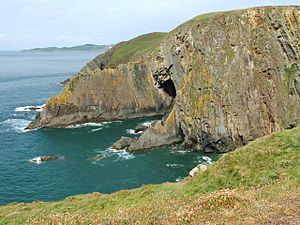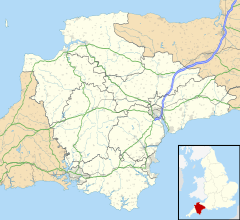Baggy Point facts for kids
Quick facts for kids Baggy Point |
|
|---|---|
 |
|
| OS grid reference | SS426403 |
| Shire county | |
| Region | |
| Country | England |
| Sovereign state | United Kingdom |
| Police | Devon and Cornwall |
| Fire | Devon and Somerset |
| Ambulance | South Western |
| EU Parliament | South West England |
Baggy Point is a beautiful piece of land that sticks out into the sea in Devon, England. It's like a natural wall between two popular bays: Croyde Bay and Morte Bay. Morte Bay is home to lovely beaches like Woolacombe and Putsborough.
Contents
Discovering Baggy Point
Baggy Point is a special place where you can explore nature and history. It's known for its amazing views, unique wildlife, and interesting rock formations. Many people visit to walk, cycle, or even try rock climbing.
A Glimpse into Baggy Point's Past
People have lived around Baggy Point for a very long time. There is proof that humans were here even in the Mesolithic era, which was thousands of years ago!
Baggy Point in World War II
During World War II, Baggy Point played an important role. American soldiers used this area to train for the Normandy Landings. This was a huge operation to land troops in France.
Owned by the National Trust
Since 1939, Baggy Point has been owned by the National Trust. This organization helps protect special places in England, Wales, and Northern Ireland. The land was given to the National Trust by Constance and Florence Hyde, so everyone can enjoy it.
A Protected Natural Area
Baggy Point is part of two important protected areas. This means its natural beauty and wildlife are carefully looked after.
Area of Outstanding Natural Beauty
It is part of the North Devon Coast Area of Outstanding Natural Beauty (AONB). An AONB is a special landscape whose beautiful scenery is protected. It's like a national park, but managed differently.
Site of Special Scientific Interest
Baggy Point is also a Saunton To Baggy Point Coast Site of Special Scientific Interest (SSSI). An SSSI is a place that has rare wildlife, plants, or geology. This SSSI is important for both its rocks and its plants.
Amazing Geology
The rocks at Baggy Point are very old, from the Upper Devonian period. These rocks are mostly sandstones. Scientists study them to learn about Earth's past. You might find fossils of tiny sea creatures called bivalves in these rocks. There are also plant remains, which tell us about ancient environments.
Unique Plants and Lichens
The SSSI is also special for its plants. You can find maritime heathland and grassland here. These are types of habitats that grow near the sea. Baggy Point is famous for its lichens. Lichens are like tiny plants that grow on rocks and trees. Some lichens found here, like Pannaria microphylla and Pannaria nebulosa, are common. Others, like Lecania ralfsii, are very rare!
Wildlife at Baggy Point
Baggy Point is a great place to spot different animals.
Birds and Sea Creatures
Many birds live or visit here. You might see guillemots and razorbills flying near the cliffs. On the land, look for Dartford warblers and stonechats. Cormorants are often seen diving for fish in the sea. If you're lucky, you might even spot seals swimming around the point!
Grazing Animals
The open fields at Baggy Point are kept tidy by special animals. Hebridean sheep and Ruby Red cattle graze here. They help to eat down plants like brambles, gorse, and bracken. This keeps the landscape open and helps other plants grow.
Fun Activities at Baggy Point
The National Trust has created many ways for people to enjoy Baggy Point.
Walking and Cycling Trails
There are different paths for walking and cycling. These trails let you explore the headland and enjoy the stunning coastal views. It's a perfect spot for an outdoor adventure!
Rock Climbing
The sandstone rocks at Baggy Point are very popular with climbers. There are many climbing routes, from easy to difficult. Some climbing spots can only be reached when the tide is low, so climbers need to check the tide times.



